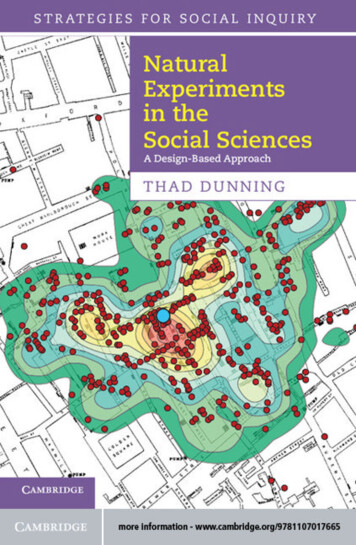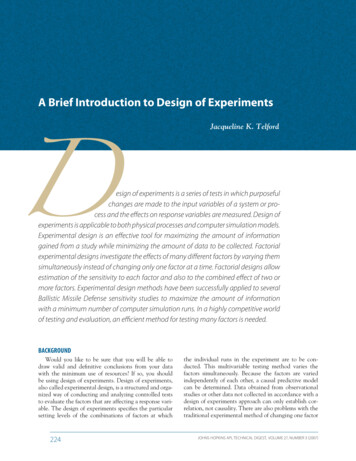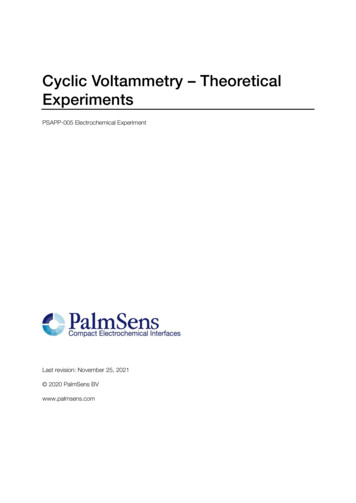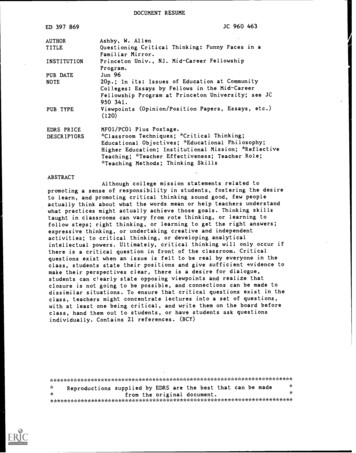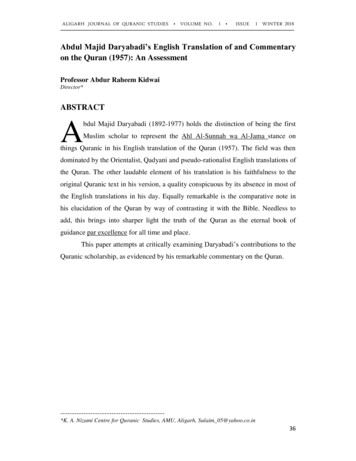
Transcription
Behavior and Philosophy, 31, 19-45 (2003). 2003 Cambridge Center for Behavioral StudiesLAUDABLE GOALS, INTERESTING EXPERIMENTS,UNINTELLIGIBLE THEORIZING: A CRITICAL REVIEW OFRELATIONAL FRAME THEORYHayes, S. C., Barnes-Holmes, D., & Roche, B. (Eds.) (2001). New York:Kluwer Academic/Plenum.José E. BurgosUniversity of Guadalajara, MexicoABSTRACT: An assessment of Relational Frame Theory (RFT) is benefited by adistinction among goals, experiments, and theorizing/philosophizing. The goals arelaudable, but not new. The experiments are interesting, but they largely involve anexpansion of the concept of relational responding from equivalence to nonequivalencerelations, the obvious next step. The theorizing, where RFT’s bona fide novelty supposedlylies, I found to be ambiguous, opaque, and contradictory. Inasmuch as unintelligibilityallowed me to understand, I found RFT to be a hypothetico-deductive and essentialisticproposal that amounts to little more than applications of basic set-theoretic (class andmembership) and logical concepts (negation, material implication, biconditional) to verbalbehavior.Key words: relational frame theory, hypothetico-deductivism, essentialism, set theory, logicThe book Relational Frame Theory (2001) is the result of a collective effort tosynthesize the multiple aspects of a proposal that, until now, has been scatteredthroughout journal articles, book chapters, and conferences. The book consists oftwo parts. Part I is entitled “The basic account” and presents the basic concepts,justification, philosophy, and experimental research of relational frame theory(RFT). Part II is entitled “Extensions and applications” and presents some of whatthe authors refer to as “implications” (p. 155) of RFT for a wide variety of topics(viz., development, education, social processes, psychopathology, and evenreligion and spirituality).An assessment of the book is aided by a distinction among goals,experiments, and theorizing. The general goal of understanding verbal behavior islaudable, but not new. The experiments are interesting, but they largely representan extension of the kinds of methods used in behavior-analytic equivalencerelation research to nonequivalence relations, the next obvious step, which, ofcourse, does not diminish its importance. The theorizing (i.e., the concepts, logic,AUTHOR’S NOTE: Please address all correspondence to José E. Burgos, Centro de Estudios eInvestigaciones en Comportamiento, Universidad de Guadalajara, 12 de Diciembre 204, Chapalita,Guadalajara, Jalisco 45030 (A.P. 5-374), México. P.O. Box in the U.S.A.: 413 Interamericana Blvd.,WH1 PMB 30-189, Laredo, TX, 78045-7926. Email: jburgos@cucba.udg.mx. CEIC’s website:http://udgserv.cencar.udg.mx/ ceip/19
BURGOSand justification), where RFT’s bona fide novelty supposedly lies, I found to beunintelligible. Such an unintelligibility prevented me from making an unequivocaldetermination of specific goals (beyond the sketchy cliché of “prediction andcontrol”), how they were to be achieved, and the significance of the experimentalresults for the achievement of any goal. I will thus focus on Part I, and, within it,on the main concepts, logic, and justification. Therefore, the present review shouldbe seen as a conceptual/logical/philosophical complement to reviews that focus onthe more experimental aspect of the book.Part I consists of eight chapters. In Chapter 1, the authors do three things.First, they summarize the Skinnerian (within which they place Willard Day’s andKurt Salzinger’s) and interbehavioral approaches to language. Second, theyidentify the philosophy of RFT with “a type of pragmatism [they] have calledfunctional contextualism” (p. 6).1 Third, they attempt to explain why none of thestandard approaches has lead to “a vibrant research program” (p. 10). In particular,their explanation regarding the Skinnerian approach arises from the idea thatSkinner’s definition of verbal behavior is “not functional” (pp. 12-13) and “toobroad” (pp. 13-15).In Chapter 2, the authors present the basic concepts of RFT, a central onebeing “relational responding,” which the authors regard as learned behavior.Specifically, it is conceptualized as an “overarching,” “generalized,” or “higherorder” (p. 23) operant, where by “operant” they mean the standard Skinneriannotion of “a functionally-defined class of responses” (p. 23). Another feature ofrelational responding is that it is “arbitrarily applicable” (p. 25) and contextuallycontrolled, where by “arbitrarily applicable” is meant “under the control of cuesthat can be modified on the basis of social whim” (p. 25). In this chapter theauthors also present a classification of relational frames into “families” dubbedwith terms such as “coordination,” “opposition,” and “comparison,” among others.In Chapter 3, the authors elaborate these basic concepts into the notions ofmultiple stimulus relations and transformation of stimulus functions. In Chapters 41The authors’ talk of “[t]he more contextualistic assumptions and approaches of the bulk of modernbehavior psychology” (p. 5, emphasis mine) could be interpreted as asserting that behaviorism is apredominantly contextualistic philosophy. If “contextualistic” refers to Pepper’s (not Popper’s!)view, the assertion is a gross misrepresentation of behaviorism. For better or worse, Pepperiancontextualists constitute a minority among behaviorists. That does not necessarily make Pepperiancontextualism false, of course. I don’t believe such a doctrine has been formulated in a sufficientlyintelligible way as to allow for an unequivocal assessment. I’m only making sure that potentialnonbehaviorist readers do not get the wrong impression that behaviorism is predominantlycontextualistic. The authors may be relying on interpretations of radical behaviorism as a form ofpragmatism (e.g., Smith, 1986; Zuriff, 1985) and believe that pragmatism entails contextualism.However, even if such interpretations were correct, talk of contextualism as a “type of pragmatism”implies that there is such a thing as noncontextualistic pragmatism (unless the authors adopt anonstandard sense of “type”). Hence, pragmatism does not entail contextualism, for apparently onecan be a pragmatist but not a contextualist. Besides, “pragmatism” in those interpretations refers tothe truth theory advanced by James (1907, 1911), and it is not obvious that functional contextualismis a form of Jamesian pragmatism. In some of the ensuing commentaries, I shall follow thoseinterpretations and use “pragmatism” to refer to Jamesian pragmatism, although in my concludingremarks I shall reject it as the worst philosophical guide one could adopt.20
UNINTELLIGIBLE THEORIZINGthrough 7 all of these notions are applied to analogies, metaphors, stories (throughthe notion of a relation of relations), thinking, problem solving, the self, and selfdirected rules. Chapter 8 is what the authors call a “précis” of RFT, where they“summarize some of the key features of RFT and. . .address some of the commonbehavioral criticisms to this approach” (p. 141).Before I make specific commentaries, I must mention two stylistic mattersthat dampened my enthusiasm from the beginning. First, in the Preface, one readsthat “[a] new day has dawned” (p. xii), which supposedly refers to RFT. Thisphrase struck me as a rather tawdry self-praise that reminded me of the obnoxiousparents who say “we’ve got the best kids in the world.” There is such a thing asbelieving too much in a theory, no matter how provocative, interesting, orpotentially fruitful. Believing too much in a theory is suspicious enough, regardlessof the believers; never mind when the believers are the very authors of the theory.In the context of such self-praise, talk of “those special few who will consider[their] arguments seriously” (p. xiii, emphasis mine) is baffling. What could theauthors possibly mean by such an unnerving phrase? Do they really expect thatonly a few readers will consider their arguments seriously? If so, why? And if not,why would they talk of those “special few who will consider [their] argumentsseriously”? And what do they mean by “special”? Do they mean that those “fewwho will consider [their] arguments seriously” will comprise an exceptional, rare,unique group, a sort of intellectual elite that is above and beyond all other researchgroups in behavior analysis and perhaps even psychology? To be completelyhonest, I found the authors’ tone here (and throughout the Preface in general) to betoo pretentious. To me, such a tone denotes a lack of wisdom, which I couldn’t butsee as an ominous sign of things to come.My point with all this is that the thing I need least when I am presented withan unfamiliar theory is praise (let alone self-praise) for it. A theory should beevaluated in and by itself, regardless of anyone’s (especially the authors’) praise.Praise is just a marketing strategy used by editorials to sell books, and self-praise isnot precisely the most objective praise. If the authors’ intention with their selfpraise was to infect readers with their enthusiasm for RFT, it had the oppositeeffect on this reader. To be sure, the authors are not the first (and won’t be the last)ones to engage in self-praise, but that’s no excuse.The second aspect of style was the authors’ warnings that the material in PartI was “inherently difficult” (p. 1, emphasis mine). The authors even say that they“have learned from experience that even sophisticated readers readilymisunderstand many of the basic concepts of Relational Frame Theory” (p. 141).So, it is the readers’ fault. The theory is clear, precise, and coherent, butsophisticated readers aren’t sophisticated enough to understand it. Apparently, tounderstand RFT one has to possess a special kind of intellect reserved for the“special few” who are “willing to take the journey.”To such warnings, I can only say that if RFT is really that inherently difficult,even its authors should have problems in understanding it. This challenge can bemet in three ways. First, the authors could acknowledge that, indeed, even theyfind their own theory difficult to understand. Second, they could consider21
BURGOSthemselves to possess the special kind of intellect that is supposedly required notonly to understand but also to create a theory that even sophisticated readers“readily misunderstand.” Third, “sophisticated readers readily misunderstand”RFT because it is obscure, ambiguous, and incoherent. Perhaps, it is the writers’fault, the possibility I will consider in the present review.The ensuing commentaries will be of two types. In one type, I point out thoseoccurrences of unintelligibility that I found to be particularly acute, in virtue ofarising from the fundamental concepts, logic, and justification of RFT. In the othertype, I criticize some of what I understood from the authors’ discourse, in spite ofits unintelligibility. Given the strategy of blaming the reader for not beingsufficiently sophisticated to understand an otherwise clear, precise, and coherentproposal, I anticipate that the present review will be dismissed by the authors andtheir followers as yet another case of misunderstanding. My only reply would bethat, indeed, I do not possess the kind of intellect required to understandunintelligible proposals. Alas, I’m not sure I want to possess such an intellect.Throughout the review, I ambiguously refer to “the authors,” by which I meanthe corresponding chapter authors. My reason is to avoid unnecessary repetition,for the authors of most chapters are the same as the editors (there is not a singlechapter that is not coauthored by at least one of the editors, and most of thechapters are coauthored by two).Social MediationPart of the justification of RFT, as presented in Chapter 1, is a rejection of theSkinnerian definition of the concept of verbal behavior as behavior whosecontrolling contingencies (specifically, its consequences) are socially mediated. Inthis regard, the authors write:Skinner purported to give a functional definition of verbal behavior, but thedefinition turns not on the history of the organism of interest, but on the historyof another organism. In no other area of behavioral thinking is a functionalresponse class defined in this way. Except in the domain of verbal behavior,“functional definitions” are always definitions stated in terms of the history ofthe individual organism and the current contextual circumstances. The differentdefinitional strategy Skinner used to define verbal behavior can lead to resultsthat are behaviorally bizarre. (p. 12)The authors then consider the case of a rat pressing a bar in an operantconditioning chamber under some experimenter-arranged reinforcement schedule.Their core argument here is that such a behavior is controlled by contingencies thatare socially mediated, insofar as reinforcement is mediated by an experimenterwhose behavior has been socially (and, to that extent, verbally) conditioned.Hence, the argument goes, the barpressing qualifies as verbal behavior underSkinner’s definition, which they regard as “behaviorally bizarre.” The authorsprovide textual evidence that even Skinner acknowledged that implication (see p.14). I have four comments in this regard. First, bizarreness is not as bad as the22
UNINTELLIGIBLE THEORIZINGauthors seem to believe. Second, the authors’ definition of “verbal behavior” leadsto equally bizarre results. Third, even if bizarreness were that bad, it could besubstantially reduced, at least in Skinner’s definition. Fourth, the authors’definition of the concept of verbal behavior seems to rely on the notion of socialmediation. Let me elaborate. It should be clear that the ensuing discussion does notrepresent a defense of Skinner’s (1957) view of verbal behavior. Rather, my mainpoint will be that a rejection of that view, based on a rejection of its definition ofverbal behavior, misses the mark.As I see it, what Skinner did was to expand the domain of functionaldefinitions. This expansion allows for descriptions of relations between thehistories of two or more individuals, which is the obvious conceptual step towardsfunctional analyses of social behavior. I will make a point about definitionstowards the end of the review. For the moment, suffice it to say that they (oranything else in science and philosophy, for that matter) are not written on stone.They are means, not ends. Transferring Humpty-Dumpty’s wise maxim, we mustbe the masters, not the slaves of our definitions. Definitions are supposed to beflexible, changeable, adaptable to our purposes, and that’s what we find inSkinner’s expansion. By restricting functional definitions to individual organisms,the authors have become slaves of such definitions.What the authors call “conceptual error” (p. 13) and “key flaw” (p. 15), then, Icall “conceptual flexibility,” and what they call “the definitional problem” (p. 13),I call “the definitional expansion.” By pretending to restrict functional definitionsto single organisms, the authors show a conceptual rigidity that shuts the door tofunctional analyses of social behavior. To be sure, Skinner’s change, as is, doeslead to behaviorally bizarre results. However, on the one hand, bizarre results are anatural outcome of conceptual change (think of the bizarre results that have arisenfrom conceptual change in relativistic, quantum, and superstring theory). Bizarreresults have not stopped scientists from embracing conceptual change, and I don’tsee why behavior analysts have to be the exception. The authors may well be rightin that leading to bizarre results is a major reason why Verbal Behavior “did notlead to a progressive research program” (p. 11). If they are (a big “if”), far fromjustifying the absence of a “vibrant research program” (p. 10) based on VerbalBehavior, what that reason does is to expose a major mistake underlying thatabsence: Emphasizing bizarre results of conceptual change over the potentialscientific progress it may allow.On the other hand, take a mand episode where person A utters “Please, passthe salt” while looking at person B, and B immediately passes the salt to A. UnderSkinner’s definition, A’s utterance qualifies as verbal behavior, not because of itstopography or the fact that A is human, but because its consequence is sociallymediated by B. Would the authors consider this result as bizarre? If not, then whyis viewing the rat’s barpressing as verbal behavior bizarre? Clearly, not because ofthe mediation per se (there’s nothing bizarre about it) but because of the fact thatrats are nonhumans and/or barpressing is not topographically linguistic. When itcomes to assessing definitions of verbal behavior, then, the nature of the speciesand/or the responses seem to be quite important for the authors.23
BURGOSMoreover, under a relational-frame notion of verbal behavior, A’s utterancedoes not qualify as verbal behavior if it does not “participate” (whatever thatmeans) in a relational frame, which is equally bizarre. If bizarreness amounts topretheoretic counterintuitiveness, rejecting an utterance such as “Please, pass thesalt” is as bizarre as regarding the rat’s barpressing as a case of verbal behavior.One bizarreness is thus replaced by another, so the issue becomes what bizarrenessis the least bizarre, which is largely undecidable. But then again, I don’t believebizarreness is that bad. I thus agree that viewing barpressing (like not viewing anutterance such as “Please, pass the salt”) as verbal behavior is bizarre, but I reallydon’t care.Just in case the reader (like the authors) cares, however, let me show thatbizarreness can be substantially reduced in the case of Skinner’s definition. Thefact that the experimenter’s behavior of mediating reinforcement of the rat’sbarpressing has been socially conditioned does not imply that the mediation is“social” (unless one is engaged in a search for the “essence” of social relations;more on essences later). The issue, then, is not that Skinner’s definition of verbalbehavior was too broad, but that his use of the term “social” was too broad. If werestrict “social” to certain interactions among members of the same species, as it isusually done in behavioral ecology and sociobiology (e.g., predator-prey relationsare not typically regarded as social), the bizarre result does not obtain, at least inthe kind of situation analyzed by the authors. No relation between an experimenterand a rat (or members of any other two species) thus qualifies as “social,” so nobehavior in the latter qualifies (technically) as verbal, no matter how much it ismediated by a socially-conditioned experimenter.The bizarre result obtains in those cases where consequence-mediation occursthanks to the behavior of other members of the same species. For example,consider the standard yoke arrangement where two operant-conditioning boxes arerigged such that responses in one determine the contingencies in the other. If thetwo boxes contain members of the same species (say, two rats, two pigeons, or twohumans), the reinforcements received by the yoked subject are socially mediatedby the master’s behavior. The relation qualifies as social and the yoked-subject’sbehavior qualifies as verbal. The bizarre result arises again, but it is restricted to amore specific kind of arrangement.One could adjust the definition of social mediation in different ways to reducethe domain of bizarre outcomes even more. For instance, one could restrict theterm “social” to relations where members of the same species have a certainminimal level of spatiotemporal proximity as to allow for some sort of sensorycontact (e.g., if they can see, touch, smell, and/or hear each other; sensory contactwith products of each other’s behavior could also be included here, to allow formail correspondence as a form of social behavior). This restriction is also standardin behavioral ecology and sociobiology. Experimental preparations in which thisrestriction is satisfied are those where two or more members of the same speciesare placed within the same experimental environment (e.g., see Galef, 2001;Schuster, 2001). In these preparations, subject interactions do qualify as social, forwhich, under a social-mediation definition of verbal behavior, any response that is24
UNINTELLIGIBLE THEORIZINGemitted by one of the organisms and is reinforced through some response that isemitted by the other, qualifies as verbal. The bizarre result obtains once again, butit is restricted to an even more specific kind of study. Far from encompassing “allanimal operant studies” (p. 14), the bizarre result (again, if it matters that much) iscircumscribed to very few ones.On closer inspection, however, the authors seem to adopt a social-mediationdefinition after all. In Chapter 2, for example, one reads:We mean arbitrarily applicable simply in the sense that in some contexts thisresponse is under the control of cues that can be modified on the basis of socialwhim. (p. 25, last emphasis mine)2Social whim thus seems to define at least arbitrarily applicable (but apparently notnonarbitrarily applied) relational frames.3 Arbitrary applicability, in turn, definesrelational frames, as stated by the authors themselves in Chapter 5: “arbitraryapplicability is a core defining feature of relational frames” (p. 89, emphasismine). If social whim defines arbitrary applicability and the latter defines(arbitrarily applicable) relational frames, then social whim defines (arbitrarilyapplicable) relational frames. This outcome is consistent with the following quote:Relational frames are arbitrarily applicable in the sense that cues can beprovided for relational responses based on social whim or convention. This is theproperty that makes relational framing inherently a form of social behavior.Indeed, much as in Skinner (1957), the training history of the “social mediator”is particularly important for that reason. (p. 150, all emphases mine)2This paragraph strongly suggests a rejection of biological constraints on verbal learning. Thisrejection becomes more obvious in the authors’ discussion of the arbitrary character of verbalbehavior, where they say: “Any event can be brought into any relation with any other event, verballyspeaking” (p. 47, emphases mine). If one reads “any” literally, then the unavoidable conclusion is thatthere are no biological constraints whatsoever on verbal learning, which, of course, is an indefensibletenet. If the authors did not literally mean “any,” then they must acknowledge that (aside from beingmisleading) there are some biological constraints on verbal learning, for which the latter is not as“arbitrary” as the authors seem to contend.3The authors make the distinction between “arbitrarily applicable” and “nonarbitrarily applied” inChapter 5, but I found it to be particularly opaque. At times, it would seem to amount to a distinctionbetween relational responding as it occurs in artificial, laboratory settings, and relational respondingas it occurs in natural-language settings, respectively. At other times, the distinction would seem torefer to one between that which could have happened and that which actually happened (e.g., thissubject actually responded in such and such way to such and such stimulus arrangement, but hewould have responded in the same way had he been presented with a different arrangement). Also,the distinction seems to be a sharp one: “[W]hile arbitrary applicability is a core defining feature ofrelational frames, in fact their use in natural language is anything but arbitrary” (p. 89, emphasismine). My reading is that there is nothing arbitrary about relational frames in natural language.However, the next two phrases read: “When relational frames are applied nonarbitrarily, the source ofcontrol is mixed. The relevant history involves both arbitrary training and nonarbitrary features of theenvironment, and the regulation of relational responses in natural settings usually comes from botharbitrary and nonarbitrary domains” (p. 89). So there seems to be something arbitrary aboutnonarbitrarily applied relational frames after all, although, again, exactly what it is eludes me.25
BURGOSI cannot but read this quote as asserting that social whim defines arbitrarilyapplicable relational frames, that it is a kind of social relation, and that it plays amediating role. Putting it all together inevitably leads to the conclusion that theRFT definition of verbal behavior relies on the notion of social mediation as muchas Skinner’s. To be sure, the kind of mediation provided by social whim in(arbitrarily applicable) relational frames is different from the one provided by thecontingency mediator in Skinner’s definition. What is socially mediated in(arbitrarily applicable) relational frames is the antecedent stimulation. But socialmediation seems to be at “the core” of both definitions of verbal behavior.Immediately after the last quote, however, one reads that “[t]he history of theaudience does not define the functional unit of language in RFT” (pp. 150-151). If“relational framing is inherently a form of social behavior” and “the traininghistory of the social mediator is particularly important for that reason,” I don’t seehow the history of the audience (or the social history of the experimenter) does notdefine the functional unit of relational framing. It would seem that by “inherently”and “particularly important” the authors do not mean “defining.” But what do theymean then? Moreover, what do they mean by “defining” and “define”? I shalladdress this issue later. For the moment, let me comment on other notions thatseem to be at the core of the notion of a relational frame.Emergence and ContextThe authors specify in Chapters 2 through 5 other notions that (apparently)characterize relational frames. Key terms here are “emergent,” “derived,”“transformed,” and “contextually controlled.” It is unclear whether the first threeare synonyms. If they are, using three different terms to talk about the sameconcept can only make the discourse more confusing. If they are not, I have noidea exactly how they differ. In any case, I suppose the authors adopt the standardsense of “emergence” found in behavior-analytic equivalence-relationexperimental research, where it refers to “not explicitly trained” or “without furthertraining.” A central notion of that research thus is also central to RFT, so the latterwill inherit any problem with the notion.One problem is that many (topographically) nonverbal behavioral phenomenain nonhumans qualify as emergent in the above sense, so emergent responding isfar more general. For example, nonverbal Pavlovian generalization in nonhumansqualifies as responding to stimuli that have not been explicitly trained, so it isemergent responding precisely in the above sense. Moreover, it qualifies asrelational responding, for one can view subjects as responding comparatively, andhence, according to what the authors call the “relational-frame family ofcomparison,” which:is involved whenever one event is responded to in terms of a quantitative orqualitative relation along a specified dimension with another event. Manyspecific subtypes of comparison exist (e.g., bigger-smaller, faster-slower, betterworse). (p. 36)26
UNINTELLIGIBLE THEORIZINGThis definition is satisfied by nonverbal Pavlovian generalization: One event (a testfrequency that has never been trained) is responded to in terms of a quantitativerelation (frequency difference in Hz) along a specified dimension (frequency) withanother event (the trained frequency).4 The specific subtype of comparison here is“higher pitch-lower pitch.” The authors thus are mistaken if they assert thatemergent responding is confined to verbal behavior, unless by “emergent” theymean something above and beyond “not explicitly trained.”As for contextual control, it is a well-established nonlinguistic-conditioningphenomenon, especially in Pavlovian conditioning (see Balsam, 1985), so there isnothing especially new or linguistic about it. Furthermore, nonlinguistic Pavlovian(e.g., Hulse, Cynx, & Humpal, 1985) and operant (Thomas, 1985) generalizationare context-dependent. If contextual control is critical to nonverbal Pavlovian andoperant generalization, and if one regards them to be critically involved in verbalbehavior, then evidently contextual control is critical to verbal behavior. Theauthors are thus asserting the obvious if they assert that contextual control iscritical to verbal behavior. However, they are mistaken if they assert thatcontextual control is confined to verbal behavior, unless, again, by “contextual”they mean something different from the standard usage of the term in contextconditioning.The authors might concede that emergence and contextual control are notconfined to verbal behavior but still reject that contextually-controlled Pavlovianand operant nonverbal generalization qualify as genuine cases of relationalresponding. That is to say, they might view relational responding as the kind ofemergence and contextual control uniquely found in verbal behavior. Or theymight even concede that relational responding is not confined to verbal behaviorbut argue that verbal relational responding is different from nonverbal relationalresponding. In any case, what is the difference between the verbal and thenonverbal? The behaviorally sensible answer would be that verbal relationalresponding is a certain phenomenon, a kind of result that is obtained by applying akind of method. If that is the case, RFT (much like behavior analysis) largelyamounts to a methodological proposal, for which it might as well be called“Relational Frame Method” (RFM).5 But then why call it RFT instead of RFM?Specifically, what does the “T” in “RFT” mean?4Of course, much depends on what one means by “in terms of.” Moreover, it is unclear how theauthors distinguish between “responding in terms of” and “responding to,” or even if
course, does not diminish its importance. The theorizing (i.e., the concepts, logic, AUTHOR'S NOTE: Please address all correspondence to José E. Burgos, Centro de Estudios e Investigaciones en Comportamiento, Universidad de Guadalajara, 12 de Diciembre 204, Chapalita, Guadalajara, Jalisco 45030 (A.P. 5-374), México.
